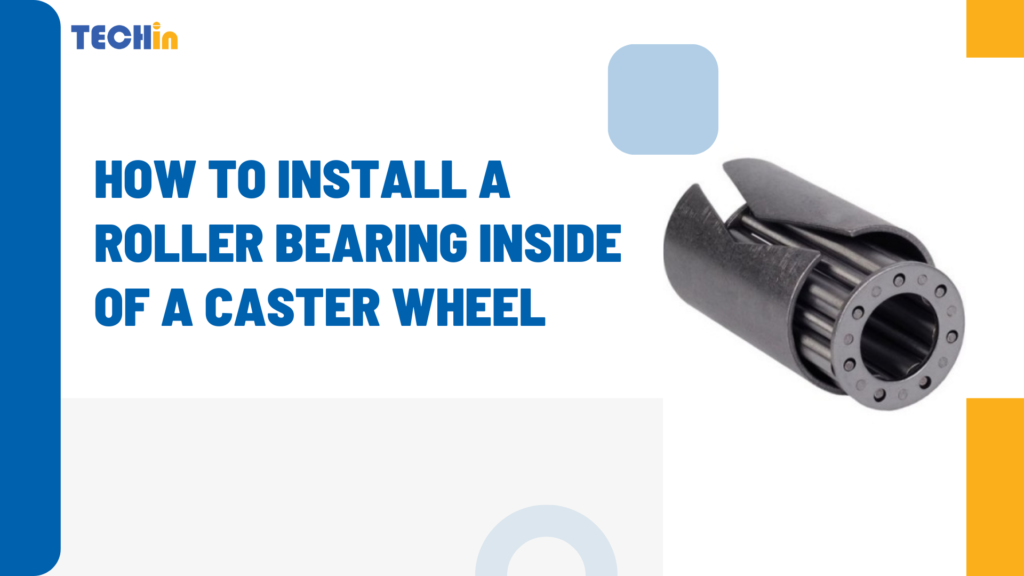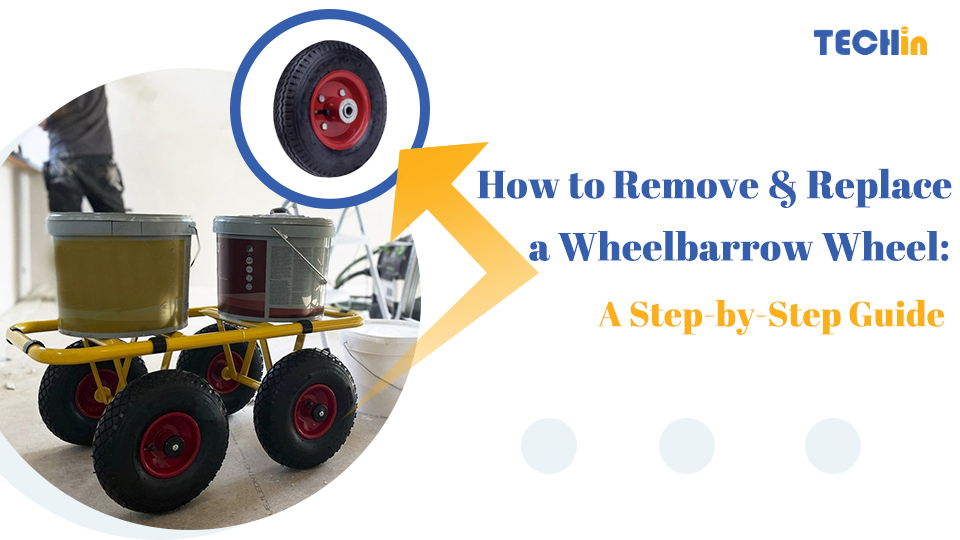Putting a roller bearing in a caster wheel might seem intimidating, but it’s important for smooth and efficient movement in many applications. Roller bearings help reduce friction and support the load of the caster wheel. If you don’t install them correctly, you’ll have problems with performance, increased wear and tear, or even damage to the caster wheel. This guide will walk you through the process of installing roller bearings so your caster wheels work smoothly and last longer.
Installing a roller bearing inside a caster wheel is a multi-step process. First, you take the wheel off the caster. Then, you clean out the hole in the wheel, put the roller bearing in, and secure it with the right tools. When you do it right, the wheel will turn smoothly under load, making it easy to move heavy things around.
Now, let’s go through the step-by-step process to make sure you install roller bearings in your caster wheels correctly and securely.
What Tools and Materials Do You Need for Installing Roller Bearings?
Before beginning the installation, gather the necessary tools and materials. Using the right tools will make the job more efficient and reduce the risk of damaging the bearings or the wheel. Here’s what you’ll need:
- Roller Bearing: Ensure the bearing is compatible with your specific caster wheel.
- Wrench or Socket Set: For removing and securing the axle bolt.
- Bearing Press or Rubber Mallet: To insert the roller bearing into the wheel bore without causing damage.
- Lubricant or Grease: To reduce friction and protect the bearing.
- Cleaning Cloth and Solvent: For cleaning the wheel bore to ensure a smooth fit.
- Safety Gloves: To protect your hands during the installation process.
- Pry Bar or Flat-head Screwdriver: To assist in removing the old bearing if necessary.
Having these tools and materials ready will streamline the installation process and help ensure a secure fit for the roller bearing.
Step-by-Step Guide to Installing a Roller Bearing Inside a Caster Wheel
1. Remove the Caster Wheel from the Caster Assembly
- Begin by placing the caster on a stable work surface. Use a wrench or socket set to loosen and remove the axle bolt securing the wheel to the caster frame. Carefully slide the wheel off the axle, taking note of any washers or spacers for reassembly.
- Tip: If the axle bolt is tight or rusted, apply a penetrating oil and allow it to sit for a few minutes to loosen the bolt.
2. Clean the Wheel Bore Thoroughly
- With the wheel removed, inspect the wheel bore where the new roller bearing will be seated. Use a cleaning cloth and a solvent to remove any old grease, dirt, or debris. A clean bore ensures the new bearing will fit properly and function efficiently.
- Tip: If there is an old bearing still in place, use a pry bar or flat-head screwdriver to gently remove it. Be cautious not to damage the wheel bore during this process.
3. Lubricate the Wheel Bore
- Apply a thin layer of lubricant or grease inside the wheel bore. This lubrication aids in the insertion of the roller bearing and helps reduce friction during operation, extending the life of the bearing.
- Tip: Avoid over-lubricating as excessive grease can attract dirt and debris, leading to premature wear.
4. Insert the Roller Bearing into the Wheel Bore
- Position the roller bearing so it aligns with the wheel bore opening. Carefully press the bearing into place. If using a bearing press, apply even pressure to insert the bearing fully into the bore. If a press is unavailable, use a rubber mallet to gently tap the bearing into place. Ensure the bearing is flush with the wheel surface and seated evenly.
- Tip: When tapping the bearing in with a mallet, place a small block of wood over the bearing to distribute the force evenly and avoid damaging the bearing.
5. Secure the Bearing
- Once the roller bearing is inserted, double-check its placement. The bearing should be snug within the bore without any gaps or movement. If the bearing is not fully seated, apply gentle pressure with the bearing press or tap it with the mallet until it’s secure.
- Tip: A properly installed bearing should rotate smoothly within the bore without wobbling.
6. Reattach the Caster Wheel to the Caster Assembly
- Slide the wheel back onto the axle, ensuring it fits securely against any spacers or washers. Reinsert the axle bolt through the caster frame and wheel, then tighten it using a wrench or socket set. Make sure the wheel spins freely without resistance or wobble.
- Tip: Do not overtighten the axle bolt, as this can cause the wheel to bind and not rotate smoothly. It should be snug but not overly tight.
7. Test the Installation
- Rotate the caster wheel manually to check for smooth and unobstructed movement. The wheel should spin freely and steadily, indicating that the roller bearing is correctly installed and functioning.
- Tip: If the wheel does not rotate smoothly or makes noise, disassemble and recheck the bearing installation for proper alignment.
How Can a Roller Bearing Be Applied in Various Industries?
Roller bearings are essential components in numerous industries due to their ability to handle heavy loads and reduce friction. Their robust design makes them suitable for various applications, such as:
- Aviation Cargo Systems: Roller bearings facilitate the movement of conveyor systems, enabling efficient handling of heavy cargo in airports and aviation warehouses.
- Heavy-Duty Machinery: In industrial settings, roller bearings support the rotation of large machinery components, providing stability and reducing wear on moving parts.
- Medical Equipment: Hospital beds and equipment carts use roller bearings for smooth movement and precise positioning, enhancing patient care and equipment handling.
- Agricultural Industry: Roller bearings are used in machinery like tractors and harvesters to support heavy loads and ensure efficient operation in challenging conditions.
These applications highlight the importance of proper installation and maintenance of roller bearings to ensure safety and performance across various sectors.
Understanding Caster Wheel Bearing Types
Choosing the right bearing type for your caster wheel is crucial for optimal performance. Here’s an overview of the common types:
- Delrin Bearing: Made from durable plastic, Delrin bearings are lightweight, corrosion-resistant, and suitable for light-duty applications where heavy loads are not a concern.
- Roller Bearing: Designed for heavy-duty applications, roller bearings can handle significant weight and provide smooth operation in industrial and commercial settings. They are ideal for equipment that requires stability and frequent movement.
- Sealed Precision Ball Bearing: Known for their quiet operation and precision, sealed ball bearings are perfect for environments where noise reduction is essential. They are also low-maintenance due to their sealed design, which prevents contamination.
Understanding these bearing types helps in selecting the appropriate one for your caster wheels, ensuring efficiency and longevity based on the specific requirements of your application.
Caster Wheel Maintenance: Ensuring Longevity and Performance
Proper maintenance of caster wheels and bearings is key to ensuring their durability and optimal functionality. Here are some maintenance tips:
- Inspect Regularly: Regularly check caster wheels and bearings for signs of wear, damage, or misalignment. Replace any worn or damaged parts promptly to avoid further issues.
- Lubricate Bearings: Periodically apply a small amount of lubricant to the bearings to maintain smooth operation. Use a lubricant compatible with the bearing material to prevent deterioration.
- Tighten Loose Parts: Inspect and tighten any loose nuts, bolts, or fittings. Loose components can lead to wobbling and uneven wear on the caster wheel.
- Clean Debris: Keep caster wheels and bearings free of dirt, debris, and other contaminants. Regular cleaning helps prevent damage and ensures the wheels roll smoothly.
By following these maintenance practices, you can significantly extend the lifespan of your caster wheels and maintain optimal performance in various applications.
Summary
Installing a roller bearing in a caster wheel is a detailed process that, when done right, makes sure your equipment rolls smoothly and efficiently. By following this guide, you’ll be able to make sure you get a good, tight fit on your roller bearing, which is important for supporting loads and reducing friction in your caster wheels. Regular maintenance and choosing the right bearing for your application will also help you get the most out of your caster wheels and make them last a long time, so you can count on them in your industrial or commercial setting.
Remember, you need to pay attention to the details when you put roller bearings in your caster wheels. You also need to take care of your caster wheels to make them last.








